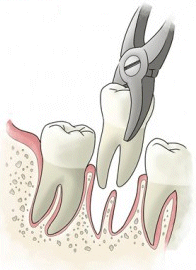
Tooth Extraction Complications
A tooth extraction is a routine dental procedure. In the majority of the procedures no complications are expected during or after the tooth extraction. But difficulties with extractions are unpredictable and sometimes complications do occur.
Tooth extraction difficulty increases when the following conditions exist: strong supporting tissues, difficult root morphology, teeth with weakened crown surfaces due to large restorations, teeth with deep caries, brittle teeth after endodontic treatment.
Procedures with higher difficulty, especially if they are performed by a less experienced dentist, increase the possibility of experiencing problems during or after tooth extraction. Oral and maxillofacial surgeons have additional training in handling complications of tooth extractions.
Tooth extraction complications during the procedure
Potential tooth extraction complications during the procedure include :
- Damage to nearby teeth. The adjacent teeth or dental restorations (e.g., crowns, bridges, implants) next to the extracted tooth may occasionally be damaged during the procedure. Nearby teeth may become fractured, chipped or loosened during the extraction of a tooth or teeth, sometimes requiring more dental work.
- Fracture of the tooth. The tooth may fracture during the extraction process, complicating the procedure and requiring more time and effort to complete the extraction. Tooth sectioning may be needed.
- Incomplete extraction. A small part of the tooth root may be left in the jawbone. Although it may increase the risk of infection, sometimes the dentist will prefer to not try to extract it because its removal may be too risky e.g. if it is very close to a nerve.
- Damage to the sinus. The extraction of a molar from the upper jaw may damage the sinus cavities above it, by creating a hole that might become a source of sinus infections. Normally the hole will heal and close by itself, but if not it may require corrective surgery.
- Nerve damage. A mistake during an extraction of a tooth from the lower jaw may damage the inferior alveolar nerve. Numbness in the lower lip and chin are common symptoms of a damaged nerve. The nerve will heal in a few weeks up to some months depending on the extend of the damage. In rare cases, the nerve is unable to heal completely, leaving the patient with a permanent numbness.
- Jaw fracture. Patients with a weak jawbone structure (e.g. older women with osteoporosis) may have a risk of jaw fracture. Even if the actual tooth extraction procedure is performed smoothly without any problems, there are cases of complications during the healing process.
Tooth extraction complications after the operation
Possible tooth extraction complications after the operation include :
- Dry socket. A dry socket following a tooth extraction is a common complication in about 5% of people who have a tooth extracted. The condition occurs when a blood clot does not form normally in the tooth socket or the blood clot is washed out or dissolved prematurely. In a dry socket situation, the underlying bone and nerves are exposed to air and food, causing intense pain and sometimes bad odor or taste. A dry socket needs to be treated with a medicated dressing to stop the pain and help healing.
- Infection. The wound of the tooth extraction can be a doorway for bacteria causing an infection, particularly in patients with a weakened immune system. If a patient has a high risk of infection the dentist will generally prescribe antibiotics before and after the extraction.
- Excessive bleeding and/or swelling, redness or fever. If you have any of these symptoms, especially if they continue after the first 24 hours, contact your dentist or oral surgeon for advice.
Why you must replace an extracted tooth
After a tooth extraction, dentists will always recommend that the extracted tooth has to be replaced by a bridge or an implant (unless the extraction was made as part of preparation for full dentures). If the tooth is not replaced, its absence may cause a series of problems in the long term. These complications because of tooth extractions include :
- Teeth misalignment. The teeth next to an extracted tooth tend to shift in the empty space left by the extracted tooth causing problems with the alignment of teeth. Potential long term risks of teeth misalignment include tooth wearing, teeth grinding (bruxism) and temporomandibular joint disorders.
- Chewing problems. The loss of a tooth, especially if it was a molar, may affect the chewing ability. Besides that, the opposing tooth will press hard foods against the soft tooth socket of the extracted tooth, causing irritation and pain.
- Loose teeth. The neighboring teeth on the sides of a tooth extraction site loose their lateral support and have increased risk of becoming loose over time.
- Cosmetic problems. The patient’s appearance is severely affected by the loss of one or more teeth.
The best treatment after tooth extractions is to replace missing teeth with dental implants.
Follow your dentist’s instructions to speed tooth extraction healing and avoid complications.
Contact your dentist if bleeding is heavy, continues for more than 24 hours or if you experience nausea, fever, chills or severe pain after tooth extraction.
![]() The cost of replacing extracted teeth can be significant and many patients may not afford it if they are not covered by their dental insurance.
Learn how to choose a dental insurance plan that will provide the best dental treatment to you and your family.
The cost of replacing extracted teeth can be significant and many patients may not afford it if they are not covered by their dental insurance.
Learn how to choose a dental insurance plan that will provide the best dental treatment to you and your family.

